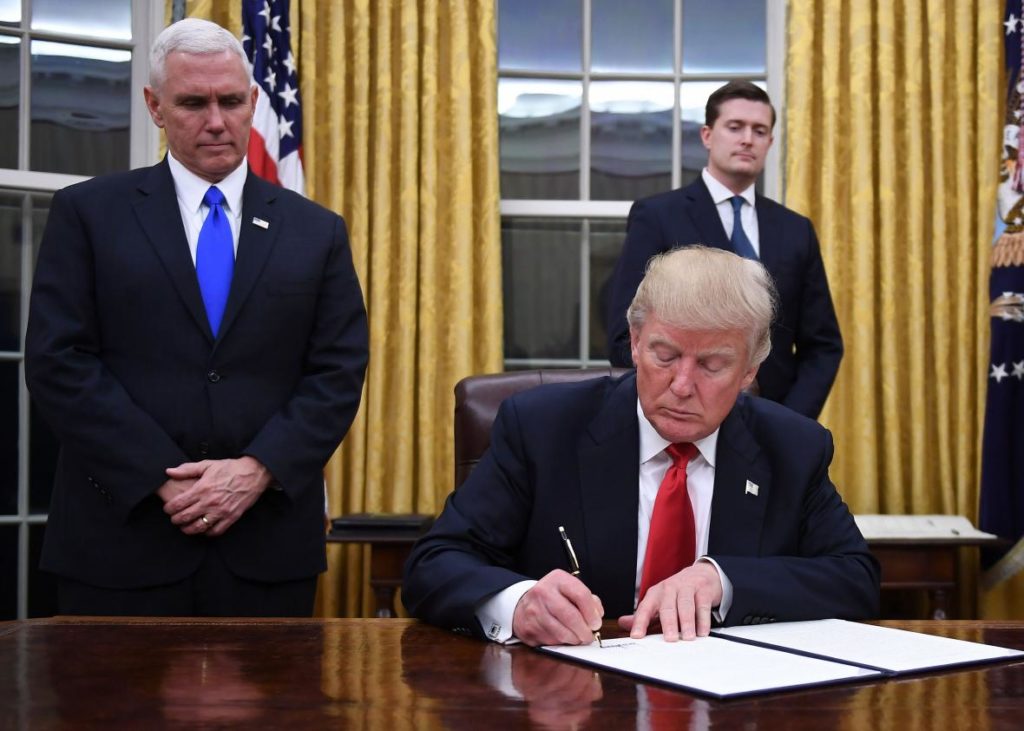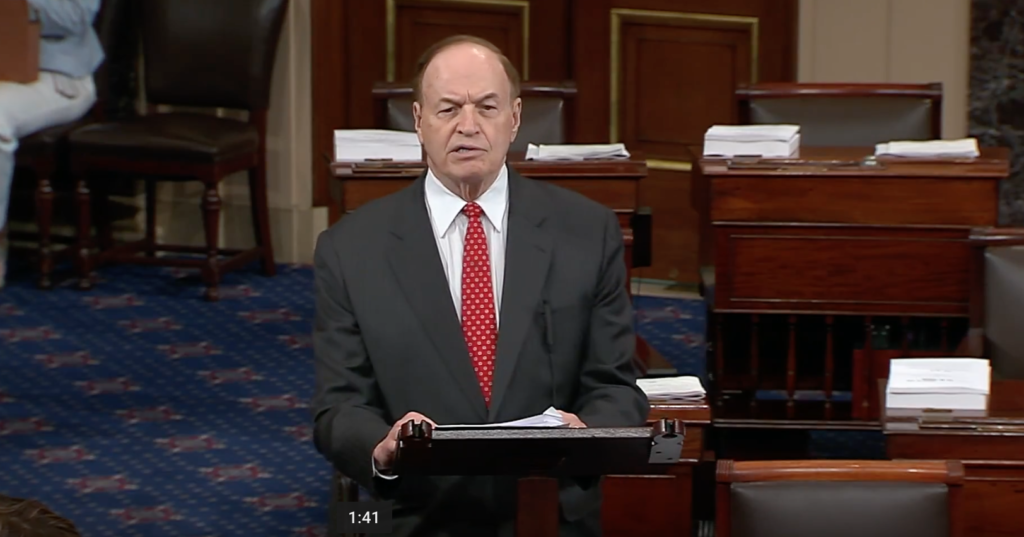Donald Trump signs appropriations ‘minibus’ into law, contains critical funding for Alabama

President Donald Trump on Friday signed into law a second appropriations “minibus,” which includes critical funding provisions for Alabama. H.R. 6157, is part of a larger package. It contains two critically important funding bills – Department of Defense and Labor, Health and Human Services (HHS), Education, and Related Agencies – which make up over half of the total discretionary budget. The bill also contains a continuing resolution (CR) through December 7, 2018, for any appropriations bills not enacted before October 1, 2018. Alabama U.S. Senator Richard Shelby, chairman of the Senate Appropriations Committee and its subcommittee on defense, on Wednesday praised the President’s signing of the second Fiscal Year 2019 appropriations minibus into law, which was supported by Congress with overwhelming margins. “The signing of this legislation marks a drastic turnaround in the way we have funded the government in recent years. As of today, 75 percent of the government is funded – on time and through an open, bipartisan process,” said Shelby. “This package continues a historic increase in funding for our nation’s defense, helping the President deliver on his commitment to rebuild the military and keep our Armed Forces the strongest and best trained, equipped, and prepared in the world. Shelby continued, “The critical funding impacting Alabama in this measure highlights our strong national defense capabilities and showcases our ability to lead the charge in medical breakthroughs and groundbreaking research. I am confident that this legislation will positively impact the lives of all Alabamians, and all Americans, and I hope we can continue down this path for the good of our nation.” The enactment of the Fiscal Year 2019 Defense and Labor-HHS-Education minibus marks the first time that America’s military has been funded on time through regular order in a decade. It also marks the first time that the Labor-HHS-Education bill has been enacted on time since 1996. With the President’s signature, five appropriations bills have been signed into law this month and 75 percent (74.9) of the government will be funded on schedule. This marks the most spending bills enacted on time since Fiscal Year 1997 – more than two decades ago. Both the Department of Defense and Labor-HHS-Education bills contain critical funding for the state of Alabama. Department of Defense funding The legislation includes the following provisions impacting Alabama: The legislation includes the following provisions impacting the production and use of missiles and helicopters in the Wiregrass region: An additional $95 million for Future Vertical Lift research, which will help accelerate development of helicopters flown at Fort Rucker. $10 million to upgrade Navy MH-60 Seahawk helicopters. $1.0 billion for Terminal High Altitude Area Defense (THAAD) missiles. $111 million for Long Range Anti-Ship Missiles (LRASMs). The measure also encourages the Navy to evaluate the capabilities and costs of a surface-launched LRASM. $307 million for Joint Air-to-Ground Missiles (JAGMs). $663 million for Joint Air-Surface Standoff Missile (JASSMs), which recently made its debut in strikes on Syria in response to their use of chemical weapons. $484 million for Hellfire missiles, which are made in Troy and used for training at Fort Rucker. $254 million for Javelin missiles for the Army and Marine Corps. The legislation includes the following provisions impacting North Alabama: Army Research – $11.1 billion for investments in transformational technologies to address modern and future Army warfighting needs. Missile Defense – $10.4 billion for the Missile Defense Agency (MDA), including $1.1 billion to support urgent MDA unfunded priorities and emergent threats. The measure included $191 million for Standard Missile Improvements, which are built in Decatur, and supports work done by MDA at Redstone Arsenal and many local companies. Directed Energy – $184 million in additional funding to further develop directed energy technology and transition these activities to both offensive and defensive capabilities. Hypersonics – $664 million in additional funding to support and accelerate offensive and defensive hypersonics research and prototyping efforts. Cyber – $306 million in additional funding to expand and accelerate cyber research across the Department of Defense, including $127 million for Army cybersecurity research efforts and $116 million in Missile Defense Agency cybersecurity enhancements. The bill encourages the enhanced use of cyber red teams to address cyber intrusions that threaten our weapons systems, an area of particular excellence for Huntsville. Space – $200 million in additional funding for Evolved Expendable Launch Vehicle (EELV) development efforts to ensure assured access to space. United Launch Alliance (ULA), which builds rockets in Decatur, continues to be seen as the most reliable and capable space launch provider. Advanced Shipbuilding Capabilities – $15 million to establish North Alabama as a center for classified, high power large-scale electron beam welding. This technology is critical to new Navy Columbia-class submarines and many high-performance aerospace systems such as hypersonic reentry vehicles, scramjet missiles, and rocket and jet engine turbomachinery. Small Glide Munitions – An additional $15 million to integrate Small Glide Munitions onto on Unmanned Aerial Systems. This highly successful weapon is used by Special Operations Command and built in Huntsville. The legislation includes the following provisions impacting Anniston: $276 million for Hydra rockets, which are built in Anniston and fired from Army and Marine Corps helicopters. Funding for Army Vehicles which are overhauled and maintained at Anniston Army Depot (ANAD): $2.5 billion to continue modernizing M1 Abrams tanks; $393 million for Stryker vehicles, including an additional $94 million to support increased Stryker DVH A1 conversions; An additional $110 million for Paladin Integrated Management artillery vehicles; and $18 million in additional funding for M88A2 Hercules Improved Recovery vehicles. The legislation includes the following provisions impacting Mobile’s shipbuilding industry: Two additional Littoral Combat Ships (LCS). One additional Expeditionary Fast Transport (EPF) ship. An additional $700 million in Advance Procurement for LPD and LHA amphibious ships. Labor, HHS, Education funding The Labor HHS Education bill includes the following provisions impacting Alabama: $39.084 billion, a $2 billion increase, for the National Institutes of Health. Opioid Funding – $3.8 billion, an increase of $206 million above FY2018. This level includes $1.5 billion for the State Opioid Response grant in SAMHSA, replacing the sun-setting 21st Century CURES funds,
Richard Shelby: Senate works to rebuild America’s military in third appropriations minibus

Alabama U.S. Sen. Richard Shelby, chairman of the Senate Committee on Appropriations, on Thursday delivered remarks on the Senate floor regarding the consideration of H.R. 6157. This bill packages two Fiscal Year 2019 appropriations measures – Department of Defense; and Labor, Health and Human Services, Education, and Related Agencies – which are the eighth and ninth funding bills to be processed by the full Senate this year. Both of the measures included in the appropriations package were passed by the full committee with near-unanimous support. “The package before the Senate makes essential investments to accelerate the rebuilding of America’s military and provides our men and women in uniform with the largest pay increase they have seen in nearly a decade. Further, it supports increased funding to advance medical research and fight the opioid epidemic,” said Shelby. “I am proud to present this legislation to my colleagues and urge their strong support. With the continued cooperation of my colleagues, I am confident that we will continue to get our work done in a deliberate and timely manner.” Watch Shelby’s floor speech below: Senator Shelby’s full remarks, as prepared, are as follows: Today the Senate begins debate on an appropriations package that is absolutely essential to the strength and security of this nation. The package before the Senate marries the two largest fiscal year 2019 appropriations bills: Defense and Labor-HHS-Education. Each of these bills carries the near unanimous support of the Appropriations Committee. The Chairman of the Labor-HHS Subcommittee, Senator Blunt, and his Ranking Member, Senator Murray, worked together to produce a strong bipartisan bill that balances many competing priorities. I commend these senators for their hard work and thank them for their continued efforts. Soon, Senators Blunt and Murray will come to the floor to discuss the particulars of the Labor-HHS division of this package, so I’m not going to get into the details of that bill. But, as Chairman of the Defense Appropriations Subcommittee, I want to provide my colleagues with an overview of the funding it contains for America’s military. Secretary Mattis – a decorated general who commands deep respect on both sides of the aisle – has warned that ‘failure to modernize our military risks leaving us with a force that could dominate the last war, but be irrelevant to tomorrow’s security.’ We cannot allow that to happen. We must rebuild America’s military. We have to defend this nation. Mr. President, I am pleased to report that this bill takes a big step in that direction. This package contains $607 billion in base defense funding. It also provides an additional $67.9 billion for Overseas Contingency Operations. The fiscal year 2018 Defense Appropriations bill, enacted earlier this year, contained the largest increase in military spending in 15 years. The bill now before the Senate does even better by providing an additional $16 billion above the fiscal year 2018 level. This funding sustains U.S. force structure and improves military readiness. It also provides critical resources for a wide range of priorities that are essential to maintaining our technological superiority in an increasingly complex and competitive national security environment. The bill includes substantial investments in the areas of basic research, hypersonics, directed energy, artificial intelligence, microelectronics, missile defense, cybersecurity, and our test and evaluation infrastructure – among many other priorities. Just as important, the package before the Senate provides our men and women in uniform with the largest pay increase they have seen in nearly a decade, and they certainly deserve it. As we debate this bill over the coming days, the sacrifices of these brave men and women should be top of mind for each of us. In light of their sacrifices, it is our duty to ensure they are the best prepared and the best equipped military in the world. The American military is the most feared fighting force the world has ever known. This bill ensures that continues to be true. That is how we defend this nation. I want to thank the Vice Chairman of the Defense Subcommittee, Senator Durbin, for his valuable input in crafting this bill. Together, I believe we have produced a balanced bill that meets the Pentagon’s objectives and includes the contributions of Senators from both sides of the aisle. I am proud to present this legislation to my colleagues and urge their strong support. In closing, I want to recognize the Vice Chairman of the full Appropriations Committee, Senator Leahy, and the Leaders on both sides, Senators McConnell and Schumer. At the outset of this appropriations cycle, the four of us met and agreed to work together in an effort to return the Senate to regular order. Since that time, the Appropriations Committee passed all 12 bills before the July 4th recess, all with strong bipartisan margins. The first time that’s been done in 30 years. The first minibus contained three bills and passed the Senate by a vote of 86 – 5. It is now in conference with the House. The second minibus contained four bills, two of which had not seen the light of day on the Senate floor in many years – Interior and FSGG. That package passed by a vote of 92 – 6. Hopefully it will soon be in conference as well. By August, the Senate had passed more appropriations bills than the House. That had not happened in 20 years. None of this would have been possible without the partnership of Vice Chairman Leahy and the leadership of Senators McConnell and Schumer. I thank each of them once again. But our work continues. We now have an opportunity to extend the success we have generated. It has been more than a decade since the Senate passed a Labor-HHS appropriations bill. And it has been a dozen years since the President was able to sign a Defense appropriations bill into law before the end of the fiscal year. These two records must be broken. We must not only provide the resources necessary to rebuild our military,


